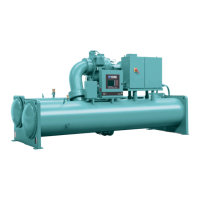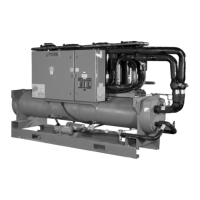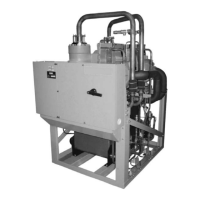• Verify that the evaporator and condenser water flows are within rated limits.
• Check the operation of the motor starter. Monitor at unit start-up for any abnormalities.
Annually (or more often if necessary)
1. For the evaporator and condenser, perform the following inspections:
a. Inspect and clean the water strainers.
b. Inspect and clean the tubes as required.
c. Inspect the end sheet.
2. For the compressor drive motor, measure the motor winding insulation resistance (megohm
testing).
3. Check and tighten all of the electrical components as necessary.
4. Clean and backflush the VSD heat exchanger.
5. Replace the VSD coolant.
6. Perform the UPS battery health check in the OptiView control center.
7. Perform a refrigerant analysis.
8. If the power fail landing increases by 1, a service technician must investigate the power loss
issue.
9. For all HYP model VSDs, conduct the Smart sensor annual test.
10. Review operating data for trends that indicate increasing vibration, or power consumption.
Checking the system for leaks
Leak testing
The refrigerant side of the system is carefully pressure tested and evacuated at the factory.
After the system has been charged, use a leak detector that is compatible with the refrigerant to
ensure that all of the joints are tight.
If any leaks are indicated, repair them immediately. At times, you can stop leaks by ensuring that
face seal nuts and flange bolts are correctly torqued. However, for any major repair, the refrigerant
charge must be removed and the system leak checked using reliable methods like a pressure test.
See Handling refrigerant for dismantling and repairs for more details.
Leak testing during operation
After the system has been charged, the system must be carefully leak tested with a refrigerant
compatible leak detector to ensure all joints are tight. The acceptable limit for a 100% pure R-134a
system is 0.1 oz/Yr at DWP.
If any leaks are indicated, they must be repaired immediately. Usually, leaks can be stopped by
tightening flare nuts or flange bolts. However, for any major repair, the refrigerant charge must be
removed.
System pressure test
With the refrigerant charge removed and all known leaks repaired, charge the system with a small
amount of refrigerant mixed with dry nitrogen. You can then use an electronic leak detector to
detect any leaks too small to be found by the soap test.
YMC
2
Mod B with OptiView Control Center
146

